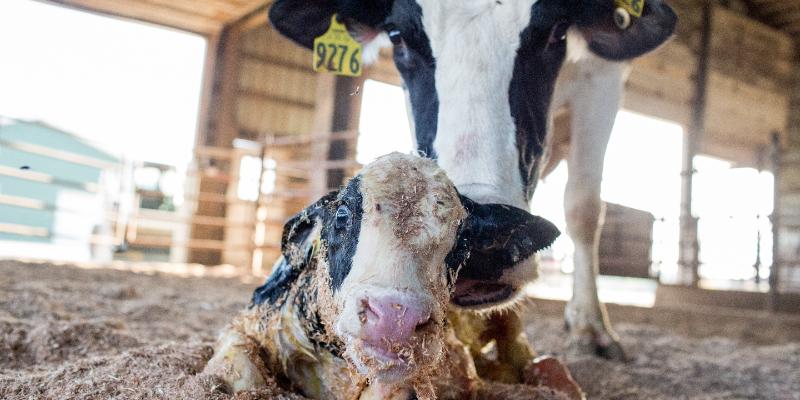-
March 23, 2022

- • Featured • Announcements
The Miracle of Life: How Cows Give Birth on a Farm
 Thank you to Dr. Tracy Potter, DVM for sharing this information for our blog.
Thank you to Dr. Tracy Potter, DVM for sharing this information for our blog.
Calves are the key to a bright future on a dairy farm. They ensure both a new generation of cows and a consistent milk supply from the current generation on the farm. With this in mind, a successful entry into the world is key. Most of the time, cows are self-sufficient and give birth completely unassisted. But what happens when things go wrong? What does the cow experience, and how does the farmer know when to help or call the vet?
The Maternity Ward
Calves spend about the same time growing in their mother as humans do, around 9 and half months. When near her due date, most cows are moved to a maternity pen. Cows instinctively search for a quiet area to give birth. To mimic this, the maternity area on a farm may be a pen away from the main flow of traffic with only one or a few cows. This helps the farmer closely monitor the cow’s progress and gives the cow a quiet, protected space to give birth, preventing rubbernecking by passing cows (and people!). Farmers watch the cow closely for signs she may be calving soon. Some common signs are filling of her udder with colostrum (the mother’s first milk), holding her tail up higher than normal, and relaxation of ligaments and tissues around her pelvis and birth canal.
Stage 1: Contractions Begin
When a cow is ready to give birth, she begins stage one of labor, which can take anywhere from four hours to a whole day. She will experience uterine contractions that increase in frequency and intensity until her water, or chorioallantois, breaks. From the outside, a farmer sees abdominal contractions and increasing restlessness of the cow. Farmers and veterinarians often wear rain gear during this stage–when that water breaks, about five gallons of fluid comes rushing out!
Stage 2: Here Comes Baby!

When the water breaks, stage two begins, and the clock starts ticking. It can take anywhere from 30 minutes to 90 minutes for baby to greet the world. Experienced cows usually take less time to have a calf. Cows typically choose to lay down on their side as the calf moves into the pelvic canal with each contraction. The farmer will watch her closely and look for progress every 15-20 minutes. First one front foot, then the other, followed by a nose, and a head! By the time the shoulders are through the birth canal, the calf is usually on the ground within minutes.
Helping Cows with Difficult Births
Farmers generally let cows do their own thing but stand at the ready to help if they notice progress has stalled or is not happening at all. Most farmers are quite skilled at assessing the problem and gently providing assistance. Sometimes it’s as simple as giving a little help by putting ropes or small, obstetric chains on the calf’s ankles and helping to pull with each of the cow’s contractions. Other times, a little more help is needed. The calf’s head may be facing the wrong way, or a foot is bent backwards. And occasionally even more assistance is needed, and a veterinarian is called.
Cow C-Sections?!
Occasionally, a veterinarian will see that there is a more severe problem that requires a cesarean section (c-section). These might include the calf simply being too big to come out, a twist in the uterus blocking the calf’s exit, or in rare cases, a genetic deformity may prevent a normal birth. A c-section usually happens right on the farm! The veterinarian and the farmer restrain the cow in a standing position, and the cow may be lightly sedated. The veterinarian preps the cow for surgery by clipping the hair on the side of her abdomen and cleaning the area with a surgical scrub and antiseptic. Then the vet uses a local anesthetic to numb the incisional area, just like the Novocain a dentist may use on a human! The veterinarian makes an incision through the body wall and the uterus, and the calf is delivered. Most cows are extremely cooperative patients for this process and appear much more comfortable when the calf is born.

A calf on the ground marks the end of stage 2. Stage 3 is a piece of cake for most cows, and simply involves continued uterine contractions until the delivery of the placenta. This stage may take up to twelve hours.
So, there you have it! Cows are amazing creatures, and we are so lucky to work with and care for them. Most farmers and veterinarians will agree, the miracle of life never gets old.
Written by: Tracy Potter, Veterinarian
Perry Veterinary Clinic, Perry, NY
